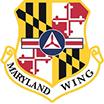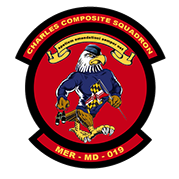Charles Composite Squadron
MER-MD-019
Group III, Maryland Wing (MDWG),
Middle East Region (MER), Civil Air Patrol (CAP)
United States Air Force Auxiliary









ABOUT CAP
History
 Civil Air Patrol was born one week prior to the Japanese attack on Pearl Harbor. Aviation advocate Gill Robb Wilson, along with New York Mayor Fiorello H. LaGuardia Director of the Office of Civilian Defense foresaw general aviation's potential to supplement America's military operations. CAP was created with Administrative Order 9, signed by LaGuardia on 1 December 1941 and published 8 December 1941. Major General John F. Curry was appointed as the first national commander. During WWII CAP assumed many missions including anti-submarine patrol and warfare, border patrols, and courier services. During World War II CAP's coastal patrol had flown 24 million miles, found 173 enemy U-boats, attacked 57, hit 10 and sank two, dropping a total of 83 bombs and depth charges throughout the conflict. By the end of the war, 64 CAP members had lost their lives in the line of duty.
Civil Air Patrol was born one week prior to the Japanese attack on Pearl Harbor. Aviation advocate Gill Robb Wilson, along with New York Mayor Fiorello H. LaGuardia Director of the Office of Civilian Defense foresaw general aviation's potential to supplement America's military operations. CAP was created with Administrative Order 9, signed by LaGuardia on 1 December 1941 and published 8 December 1941. Major General John F. Curry was appointed as the first national commander. During WWII CAP assumed many missions including anti-submarine patrol and warfare, border patrols, and courier services. During World War II CAP's coastal patrol had flown 24 million miles, found 173 enemy U-boats, attacked 57, hit 10 and sank two, dropping a total of 83 bombs and depth charges throughout the conflict. By the end of the war, 64 CAP members had lost their lives in the line of duty.
After the war, a thankful nation understood that Civil Air Patrol could continue providing valuable services to both local and national agencies. On July 1, 1946, President Harry Truman signed Public Law 476 incorporating Civil Air Patrol as a benevolent, nonprofit organization. On May 26, 1948, Congress passed Public Law 557 permanently establishing Civil Air Patrol as the auxiliary of the new U.S. Air Force. Three primary mission areas were set forth at that time: aerospace education, cadet programs, and emergency services.
Cadet Programs
 While there are many youth oriented programs in America today, CAP's cadet program is unique in that it uses aviation as a cornerstone. Thousands of young people from 12 years through age 21 are introduced to aviation through CAP's cadet program. The program allows young people to progress at their own pace through a 16-step program including aerospace education, leadership training, physical fitness and moral leadership. Cadets compete for academic scholarships to further their studies in fields such as engineering, science, aircraft mechanics, aerospace medicine, meteorology, as well as many others. Cadets who complete the General Billy Mitchell award earn cadet officer status. Should they chose to enlist in the Air Force they will enter as an E3 (Airman First Class) rather than an E1 (Airman Basic).
While there are many youth oriented programs in America today, CAP's cadet program is unique in that it uses aviation as a cornerstone. Thousands of young people from 12 years through age 21 are introduced to aviation through CAP's cadet program. The program allows young people to progress at their own pace through a 16-step program including aerospace education, leadership training, physical fitness and moral leadership. Cadets compete for academic scholarships to further their studies in fields such as engineering, science, aircraft mechanics, aerospace medicine, meteorology, as well as many others. Cadets who complete the General Billy Mitchell award earn cadet officer status. Should they chose to enlist in the Air Force they will enter as an E3 (Airman First Class) rather than an E1 (Airman Basic).
Whatever your interests-survival training, flight training, photography, astronomy-there's a place for you in CAP's cadet program. Each year, cadets have the opportunity to participate in special activities at the local, state, regional or national level. Many cadets will have the opportunity to solo fly an airplane for the first time through a flight encampment or academy. Others will enjoy traveling abroad through the International Air Cadet Exchange Program. Still others assist at major air shows throughout the nation.
Emergency Services
 Growing from its World War II experience, the Civil Air Patrol has continued to save lives and alleviate human suffering through a myriad of emergency-services and operational missions.
Growing from its World War II experience, the Civil Air Patrol has continued to save lives and alleviate human suffering through a myriad of emergency-services and operational missions.
Search and Rescue
Perhaps best known for its search-and-rescue efforts, CAP flies more than 85 percent of all federal inland search-and-rescue missions directed by the Air Force Rescue Coordination Center at Tyndall Air Force Base, Fl. Outside the continental United States, CAP supports the Joint Rescue Coordination Centers in Alaska, Hawaii and Puerto Rico. Just how effective are the CAP missions? Nearly 100 people are saved each year by CAP members.
Disaster Relief
Another important service CAP performs is disaster-relief operations. CAP provides air and ground transportation and an extensive communications network. Volunteer members fly disaster-relief officials to remote locations and provide manpower and leadership to local, state and national disaster-relief organizations. CAP has formal agreements with many government and humanitarian relief agencies including the American Red Cross, Federal Emergency Management Agency, Federal Aviation Administration, National Transportation Safety Board and the U.S. Coast Guard.
Humanitarian Services
CAP flies humanitarian missions, usually in support of the Red Cross-transporting time-sensitive medical materials including blood and human tissue, in situations where other means of transportation are not available.
Air Force Support
It's hardly surprising that CAP performs several missions in direct support of the U.S. Air Force. Specifically, CAP conducts light transport, communications support, and low-altitude route surveys. CAP also provides orientation flights for AFROTC cadets. Joint U.S. Air Force and CAP search-and-rescue exercises provide realistic training for missions.
Counterdrug
CAP joined the "war on drugs" in 1986 when, pursuant to congressional authorization, CAP signed an agreement with the U.S. Air Force and U.S. Customs Service offering CAP resources to help stem the flow of drugs into and within the United States.
Aerospace Education
 The Aerospace Education Program provides aviation related education and educational activities for members, including formal, graded courses about all aspects of aviation including flight physics, dynamics, history, and application. Courses covering the space program, and new technologies and advances in aviation and space exploration, are also available. To advance within the organization, members are required to participate in the educational program. Aerospace educators at CAP's National Headquarters at Maxwell Air Force Base, Ala., provide current materials that reflect the highest standards of educational excellence.
The Aerospace Education Program provides aviation related education and educational activities for members, including formal, graded courses about all aspects of aviation including flight physics, dynamics, history, and application. Courses covering the space program, and new technologies and advances in aviation and space exploration, are also available. To advance within the organization, members are required to participate in the educational program. Aerospace educators at CAP's National Headquarters at Maxwell Air Force Base, Ala., provide current materials that reflect the highest standards of educational excellence.
Through outreach programs CAP helps school teachers integrate aviation and aerospace into the classroom by providing seminars, course materials. Each year, CAP sponsors many workshops in states across the nation, reaching hundreds of educators and thereby thousands of young people. These workshops highlight basic aerospace knowledge and focus on advances in aerospace technology. CAP's aerospace education members receive more than 20 free aerospace education classroom materials.
Per CAP REGULATION 110-1: LINKS OR REFERENCES TO INDIVIDUALS OR COMPANIES DOES NOT CONSTITUTE AN ENDORSEMENT OF ANY INFORMATION, PRODUCT OR SERVICE YOU MAY RECEIVE FROM SUCH SOURCES
Copyright 2011/2014 Composite Squadron. All Rights Reserved., Powered by PTC Information Technology